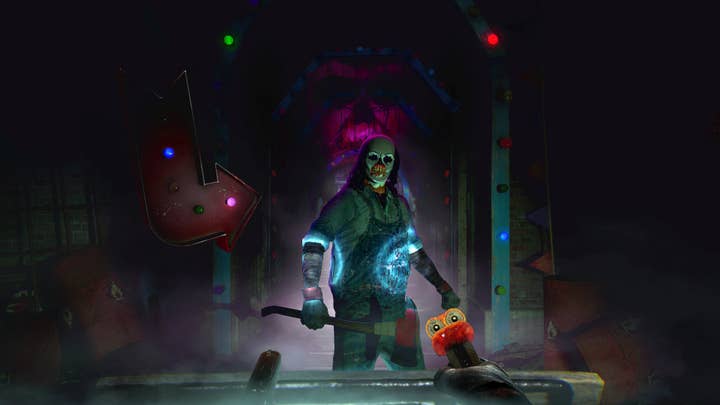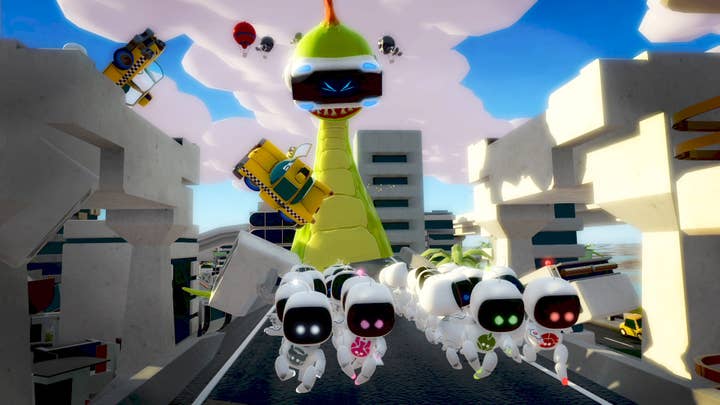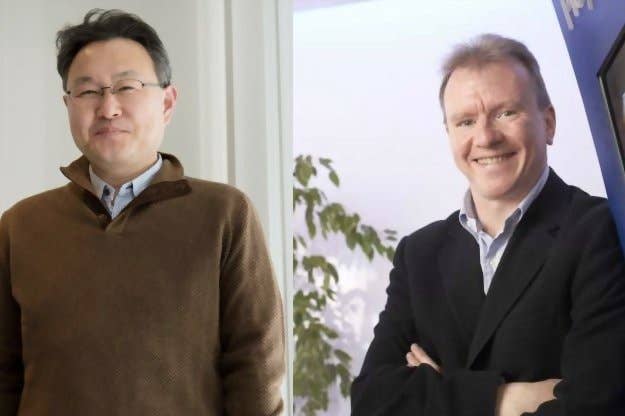Two Sony presidents, one VR revolution
Two executives are better than one when it comes to talking pricing, strategy and VR games of the future
Even at a show that revolved around VR, Sony managed to steal the virtual limelight at GDC by announcing a release date and a very reasonable price for its PSVR headset, showcasing an impressive lineup of games and promising social experiences on top. The corporation also had a healthy set of top-level executives on hand to answer questions about the forthcoming hardware, so we spoke to Shuhei Yoshida, president of Worldwide Studios, and Jim Ryan, president and CEO of Sony Computer Entertainment Europe, about the big announcements and their impact on PlayStation's brand, the industry and the developers within it.
At the time of the reveal, there were two clear points in Sony's favour in the rapidly heating VR cold war: PSVR was going to be the cheapest of the front runners, and it was going to be the simplest to use in terms of hardware requirements. Since then, one of those issues has been muddied by the ongoing rumours of the PS4.5, and whether the extra oomph of that potential hardware refesh will improve the VR experience. However, Sony's price of $399/£349/€399 will still be a deciding factor in many players' purchasing decision. Given the $200 distance between PSVR and Rift, not to mention the Vive, surely Sony must be following the usual console model of selling hardware at a loss in the first iteration? Not according to the executives.
"Actually we are not losing money at that price," Yoshida told us. "From day one we are able to deliver that comfortably from our standpoint as well, so we can spend money on doing demos and helping developers."
"So I'm saying that everybody is excited, but the true test is in six months"
Shuhei Yoshida
Ryan was quick to confirm the margin, reaffirming that "We will be making money on the hardware from day one."
With the company still basking in the warmth of public reception, reports began to surface that pre-orders for the headset were already selling out across Europe on the sites of major retailers like Amazon. Ryan sees that as a solid confirmation that the company is on the right track, although he was unwilling to go into finer details on what sorts of raw numbers those pre-orders represented.
"We're not disclosing that level of detail, but I've seen those reports, I've seen our internal data, I've seen our internal dialogue with the retailers and, you know, the reaction has been-, in the space of 24 hours or less it's been pretty spectacular," he said.
"And that's great, because you do a press release in front of a bunch of journos, many of whom are avid gamers, and get a good reaction, and that's really nice. But it's only when you see what the gamers on the street in their many thousands, how they're reacting, that you really realise, 'We might be on the road to getting this right.' Early days though."

Yoshida was able to give a little more insight into the headset's October release date. It puts PlayStation a little bit behind the Oculus Rift and the HTC Vive, but he feels it's crucial to ensure maximum consumer happiness.
"We always targeted the first half of the year, so I was kind of expecting a June/E3 timeframe. The hardware development is done, It has been on schedule and so we are super happy," he explained.
"But because of the heightened anticipation and excitement around VR we realised that our assumption of initial day one units won't be enough to satisfy the demand. We didn't want to stagger the launch by region because it's such a hot item, people in some regions will be totally upset if we delay release. So we wanted to make sure that we can cover as many countries as possible, that's why we had to decide to delay so that we can manufacture enough units for day one.
"I also think the boundary between what's a game and what's a non-interactive experience is gonna become extremely blurred in this area"
Jim Ryan
"And the good thing about doing so is all the developers, including ourselves, can spend that time polishing the experiences. That's all good for the consumers as well, so that's why we decided."
With retailers now suggesting that those who missed the first allocation of pre-orders may have to wait for their units, it's possible that demand has outstripped even those expectations. But Yoshida says Sony isn't taking its foot off the pedal, hinting that we can expect to see more software announced at E3. Nonetheless, what was on show at Sony's PlayStation GDC event already felt like a varied and comprehensive offering. From social experiences that Yoshida thinks could become a new type of online lobby for VR games to Gary The Gull to Until Dawn: Rush Of Blood - a nightmarish rollercoaster ride into the lair of a psychopath - it felt like a good start for a new medium.
"I'm a big fan of story-based experience, and one of the things we showed was Allumette, the girl with the match. That's a cute short story. It's very intriguing those companies, those people who came from the movie industry and want to create some very immersive storytelling on VR. We are not good at those, so I'm personally very excited that those kind of people are coming over to make something very interesting in VR."
Ryan had also seen people reacting well to the more immersive, story-based experiences, and suggested Sony was keeping an eye on the potential for VR beyond the gaming core.

"I've had this several times already this morning, really avid gamers who have really enjoyed these sorts of tangential experiences. Clearly a lot of this stuff has the opportunity to be really relevant to our gamers. I also think the boundary between what's a game and what's a non-interactive experience is going to become extremely blurred in this area. You're already starting to see that. So principally it's on PlayStation, so it's gonna be about games, but we're looking at a lot of this other stuff, and, as Andy House said in his speech, there's more to follow in this area over weeks and months to come."
Part of the reason Sony can offer such a breadth of VR experiences is its close relationship with the development community, particularly when it comes to virtual reality. Yoshida explains:
"On the third-party front we have very hard-working groups in the US and in Europe. They are always talking to developers and trying to find great teams to support, to find out what they need, what they want, and what we can offer depending on their needs: some financial support or some PR or featuring their games. All different kinds of things so that we are able to present a variety of titles.
"We have very talented developer relations people. They are always talking to developers, whether it's about VR or not. They have to continue to do that, but that's why they exist. So that's how they struck a deal with EA and LucasArts so that we were able to announce Star Wars Battlefront for VR. Even I was surprised."
"People ask me what's your killer title, I always say that it will come from nowhere"
Shuhei Yoshida
When asked about the future for virtual reality as a medium, both Sony bosses were understandably excited but vague about strategy. Ryan was asked if the PSVR headset could ever become a standalone platform, whether there could be a diverging path between the HMD and the screen-based console.
"Viewed from a certain angle it's a subset of the PS4, right? But viewed from another angle, the content that has been developed for PlayStation VR is bespoke to PlayStation VR, so from that perspective it's a platform in its own right. It's a bit of both. Now, where that goes in the future is anybody's guess.
"But the possibilities are genuinely exciting, because when you get those sorts of technology step changes, the people who create entertainment can often do something that's completely different and completely transformational, never done before, and there's the potential for that to be the case here."
Yoshida compared PlayStation VR to another major turning point for Sony, and the games industry as a whole, over 20 years ago: the creation and launch of the original PlayStation.
"I did a lot of interviews for the 20th anniversary of PlayStation and every time I was asked when the most fun time was, I always answered that it was the launch of the first PlayStation. That was the very first time that developers were able to use 3D real-time graphics for games, and they didn't know what they could do with it other than racing games or shooting games. Lots of games like Final Fantasy 7 or Tomb Raider came out and developers realised, 'Wow, we can create something totally new'. And new developers, creators, came from other fields at that time, people like Masaya Matsuura from the music industry who created PaRappa The Rapper and started music based games. So it was so fun to see so many creative people coming in and start making something I was not expecting.
"So I feel the same, even more so, with VR. Including non-gaming experiences that every month are a surprise, it's hard to keep track of the announcement of new titles. Like the last couple of weeks everyone is talking about Budget Cuts - what is Budget Cuts? [Laughs] I've watched the video, it looks very good, and those people came from nowhere! So people ask me what's your killer title, I always say that it will come from nowhere.
"Everybody is excited, but the true test is in six months. One year after the launch of PSVR, the worst thing that could happen is that developers have created great games with their own money or someone's investment and they couldn't recoup it, so they decide to leave making VR games. So I'll be happy only when I see it six months after the launch."
Shuhei Yoshida interview conducted by Rachel Weber. Jim Ryan interview conducted by Dan Pearson.
